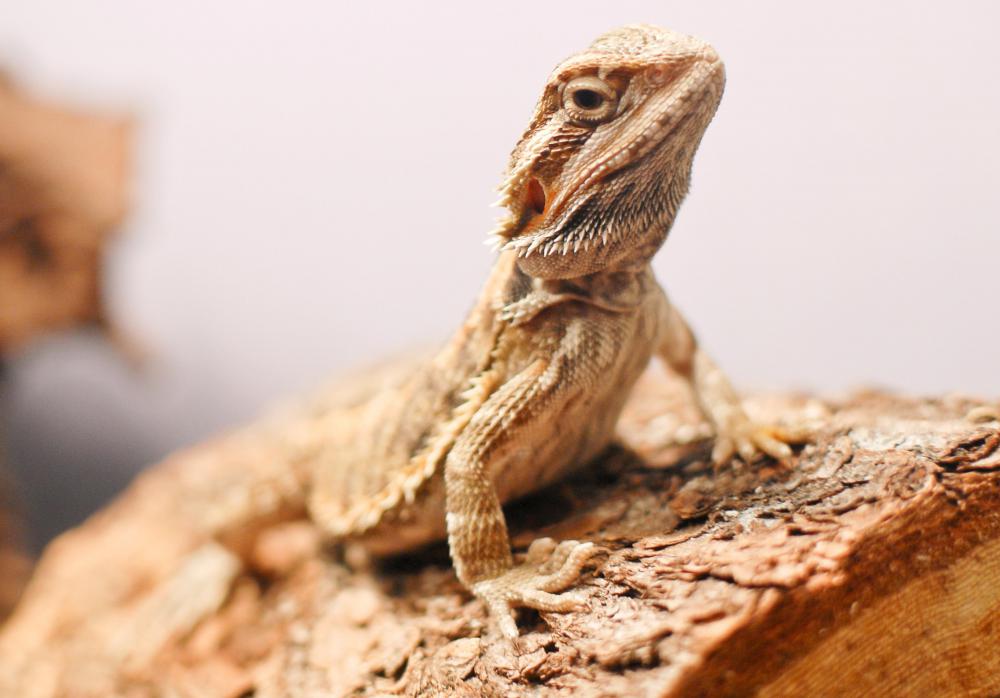At AllThingsNature, we're committed to delivering accurate, trustworthy information. Our expert-authored content is rigorously fact-checked and sourced from credible authorities. Discover how we uphold the highest standards in providing you with reliable knowledge.
What Factors Affect the Life Span of a Bearded Dragon?
The life span of a bearded dragon is primarily affected by its habitat, the available food supply, and the presence of predators or parasites. Pet bearded dragons generally live longer than those in the wild. The average life span of a bearded dragon is between five and eight years. With a nutritious diet and adequate medical care, a bearded dragon can live up to 12 years.
Bearded dragons are native to Australia and Tasmania. They live in a variety of habitats, including forested areas and rocky deserts. These reptiles are most active during the day, but they prefer to keep to deep burrows when the temperature is too hot or too cold. Like other cold-blooded reptiles, bearded dragons cannot self-regulate their internal temperature and must rely on the ambient temperature to keep them warm or cool.

Available food supply can also affect the life span of a bearded dragon. In the wild, these reptiles eat fruit, flowers, and insects. Pet bearded dragons are fed a similar diet, along with as vitamins and minerals, especially calcium. Bearded dragons are prone to developing calcium deficiencies. Low calcium, or hypocalcemia, can cause weak bones and poor muscle or nerve function. Feeding a bearded dragon greens and other foods high in calcium may not provide adequate calcium, so supplements are typically required.

Live food is usually purchased from pet stores to provide proper nutrition for bearded dragons. Crickets are the most popular, though meal worms, young Madagascar hissing cockroaches, and wax worms are also good sources of protein. Offering live prey from gardens or other neighborhood areas with insect populations can pose a potential threat to the life span of a bearded dragon, because unlike commercially-bred insects, native insects can be exposed to pesticides. Consuming insects that have been exposed to pesticides can injure or kill a bearded dragon.

A bearded dragon’s food supply can shorten its life span in another way. If crickets are not removed from a bearded dragon’s habitat while it is sleeping, they can bite the reptile during the night, causing injury and possibly infection. Having too many crickets in its enclosure can also place stress on the bearded dragon, weakening its immune system.
Certain diseases can negatively affect the life span of a bearded dragon. These reptiles are relatively healthy creatures, but they are sometimes susceptible to internal and external parasites, gastrointestinal or respiratory infections, and pseudomona, a bacterial infection that affects major organs. Bearded dragons are also susceptible to coccidia, tiny protozoa that can cause severe diarrhea and dehydration.
Frequently Asked Questions
What is the average lifespan of a bearded dragon in captivity?
Bearded dragons typically live for 8 to 12 years in captivity when provided with proper care. This lifespan can be extended with optimal husbandry practices, including a balanced diet, appropriate lighting and heating, and regular veterinary check-ups. Some bearded dragons have been known to live up to 15 years under exceptional care.
How does diet affect a bearded dragon's lifespan?
A balanced diet is crucial for a bearded dragon's longevity. A diet rich in variety, including leafy greens, vegetables, and occasional fruits, supplemented with insects like crickets and mealworms, provides essential nutrients. Overfeeding or an imbalanced diet can lead to obesity and nutritional deficiencies, shortening their lifespan.
Can the habitat setup impact the life expectancy of a bearded dragon?
Yes, the habitat setup significantly impacts a bearded dragon's life expectancy. A spacious enclosure with proper temperature gradients, UVB lighting, and areas for basking, hiding, and exercise mimics their natural environment, promoting physical and mental health. Inadequate habitats can lead to stress and illness, reducing their lifespan.
What role does UVB lighting play in the health and lifespan of bearded dragons?
UVB lighting is vital for bearded dragons as it enables them to synthesize vitamin D3, which is essential for calcium metabolism. Without adequate UVB exposure, they can develop metabolic bone disease, which can be fatal. Proper UVB lighting contributes to overall health and can help maximize their lifespan.
How does breeding affect a female bearded dragon's lifespan?
Frequent breeding can shorten a female bearded dragon's lifespan due to the physical demands of egg production and laying. It can lead to calcium depletion and increased stress. Limiting the number of breeding cycles and ensuring she has ample recovery time and nutrition can help maintain her health and longevity.
What common health issues can reduce the lifespan of bearded dragons?
Common health issues that can reduce the lifespan of bearded dragons include metabolic bone disease, respiratory infections, impaction, and parasitic infections. Early detection and treatment of these conditions are critical. Regular health check-ups with a reptile-savvy veterinarian can help identify and manage health issues promptly, supporting a longer, healthier life.
AS FEATURED ON:
AS FEATURED ON:













Discuss this Article
Post your comments